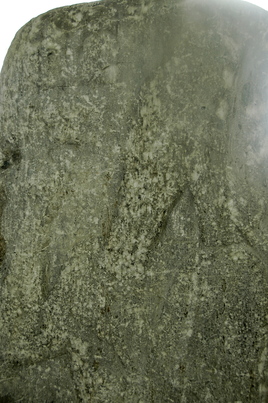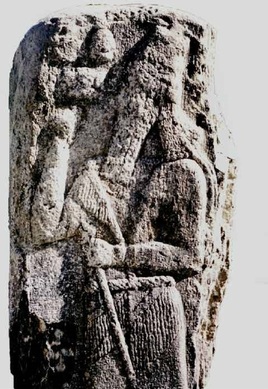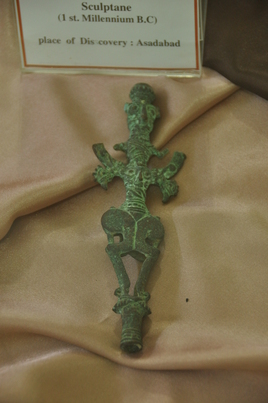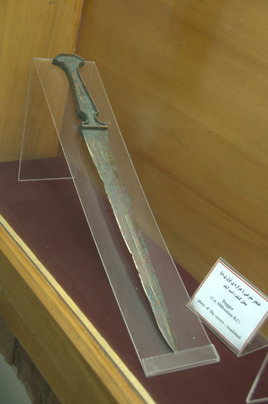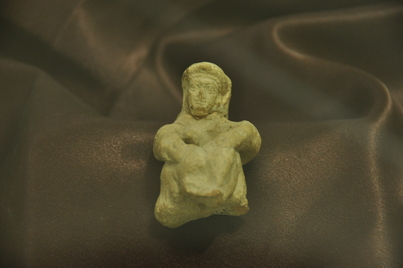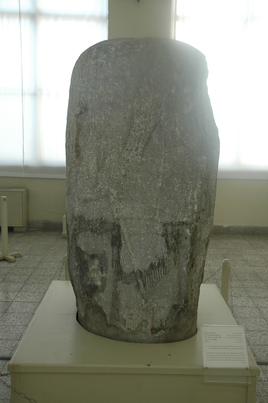Il n'y a pas une annotation en français. Présenté est une annotation en Anglais.
The Najafehabad Stele-Najafabad Stele in the Assadabad Valley unearthed in 1965 during earhworks for house build of local inhabitant. The stele is currently on display at the National Museum in Tehran. The front side of the stele depicts Sargon II in front of gods symbols, with his hands in gesture of supplification or worship. The opposit side commemorate the first sixt years of Sargon`s reign.(721-715 BC) The last preserved section of the inscription discribes the creation of the stele1.
See:
- Alibaigi, S., Rezaei, I. & Beheshti, S. (2018). Najafabad, Sargon II’s Stele, and Mount Urattus: The Geological and Archaeological Evidence. Zeitschrift für Assyriologie und vorderasiatische Archäologie, 107(2), pp. 261-273. Retrieved 10 Nov. 2019, from doi:10.1515/za-2017-0102
- Grant Frame, Two Monumental Inscriptions of the Assyrian King Sargon II (721–705 BCE) in Iran: The Najafehabad Stele and the Tang-i Var Rock Relief, in: Collection of Papers pesented to The Third Biennial International Conference of the Persian Gulf (History, Culture and Civilisation), Univeristy of Teheran Press 2013, pp.433-446
Références
- ↑ ii 70b–71) At that time, I had a stele made and [ Iengraved upon it ]image(s) of the great gods, my lords, who make me triumph ... [...]. Iinscribed upon it [(...)] the victorious deeds of Aššur, my conquests that I made over the four quarters (of the world), ( and )everything that Ihad done in the city of Ki -x-x. [ Ierected ( it )] in the city of Ki-sa-si ,which (my) hands had cap[tured], for ... [...].
The Najafehabad Stele-Najafabad Stele in the Assadabad Valley unearthed in 1965 during earhworks for house build of local inhabitant. The stele is currently on display at the National Museum in Tehran. The front side of the stele depicts Sargon II in front of gods symbols, with his hands in gesture of supplification or worship. The opposit side commemorate the first sixt years of Sargon`s reign.(721-715 BC) The last preserved section of the inscription discribes the creation of the stele1.
See:
- Alibaigi, S., Rezaei, I. & Beheshti, S. (2018). Najafabad, Sargon II’s Stele, and Mount Urattus: The Geological and Archaeological Evidence. Zeitschrift für Assyriologie und vorderasiatische Archäologie, 107(2), pp. 261-273. Retrieved 10 Nov. 2019, from doi:10.1515/za-2017-0102
- Grant Frame, Two Monumental Inscriptions of the Assyrian King Sargon II (721–705 BCE) in Iran: The Najafehabad Stele and the Tang-i Var Rock Relief, in: Collection of Papers pesented to The Third Biennial International Conference of the Persian Gulf (History, Culture and Civilisation), Univeristy of Teheran Press 2013, pp.433-446
Références
- ↑ ii 70b–71) At that time, I had a stele made and [ Iengraved upon it ]image(s) of the great gods, my lords, who make me triumph ... [...]. Iinscribed upon it [(...)] the victorious deeds of Aššur, my conquests that I made over the four quarters (of the world), ( and )everything that Ihad done in the city of Ki -x-x. [ Ierected ( it )] in the city of Ki-sa-si ,which (my) hands had cap[tured], for ... [...].
Assyrian relief of Sargon II

